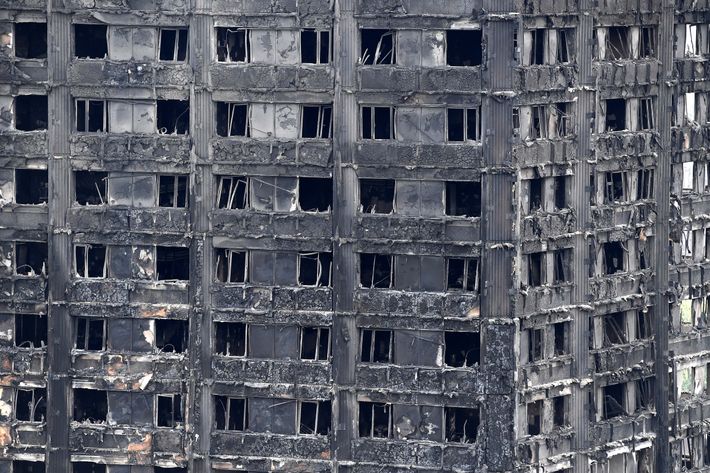
There is no such thing as an accident when a high-rise building fails. If gas leaks, wires spark, or a wall crumbles, those are not acts of fate, but the preventable consequence of people not doing their jobs. Terminology matters; if it turned out that the fire that consumed Grenfell Tower in London, killing at least 30 people (and probably many more), had been set by a radicalized Muslim immigrant or an anti-Muslim white supremacist, those facts would shape the U.K.’s foreign and security policies. If it’s just an instance of faulty construction, politicians can wring their hands on television, appropriate some emergency funds, and then move on.
It’s too soon to be sure exactly what caused the Grenfell Tower to burn. A thick plume of accusations suggests a lot of possible culprits: a faulty refrigerator; the recently installed cladding of cheap aluminum panels with a flammable core; the gap between the wall and the rain screen, which could have created a chimney effect and sped flames and smoke up the building’s exterior; ineffectual fire alarms; a lack of sprinklers; the presence of just a single fire stair. Behind the technical factors is another layer of social issues. Residents have accused building management and authorities of ignoring their chillingly specific complaints, perhaps because of a generalized disinterest in the building’s poor and largely Muslim population, or because of the pressures of gentrification from the neighborhood all around.

New Yorkers might be tempted to react complacently to some items on this list. Aluminum panels are common, but the slightly less expensive version with the flammable polyethylene core is not legal here. All buildings higher than 50 feet must have automatic sprinklers and two fire stairs, not one. And yet to argue those points is to miss the larger awfulness of the situation. Whether the proximate causes turn out to be corruption, venality, racism, or some combination of all three, the underlying sin is contempt for the people who must live in conditions they cannot control. If residents of subsidized housing had truly mattered, then more questions would have been asked during the building’s recent renovation, fire codes updated, circumstances foreseen. The plastic-and-aluminum panels on Grenfell Tower’s skin were also involved in three catastrophic fires in Dubai — and yet somehow the global community of architects, engineers, regulators, façade consultants, and construction firms continues to permit their use.
Contempt also shapes official attitudes to public housing in the United States. It explains why President Trump appointed Ben Carson, a doctor with no expertise or avowed interest in housing issues, to run the nation’s Department of Housing and Urban Development. Contempt explains why he named an amateur, Lynne Patton, a family loyalist who plans weddings and golf tournaments, to run the New York/New Jersey section of HUD. These are not casual appointments: They send a clear signal that people in public housing shouldn’t be there and deserve no better.
NYCHA, an agency responsible for the living conditions of more than half a million New Yorkers, is in such deep financial distress that its buildings are allowed to decline into lethal states of disrepair. Last year, a malfunctioning elevator killed 84-year-old Olegario Pabon. A fire in another apartment killed two toddler sisters, Amanda and Jannubi Jabie, after a maintenance worker noticed a malfunctioning smoke detector and did nothing. A panicked cop in a stairwell darkened by burned-out bulbs accidentally shot and killed Akai Gurley. The fact that these deaths occur one or two at a time, instead of in one catastrophic blaze, does not excuse their horror.

No government agency even builds public housing much any more; instead all three levels of government subsidize private developers or mission-driven nonprofit organizations. In New York, many of these apartments are “affordable” in only the loosest sense of the word. Still, they are usually adequately designed, robust, and managed by owners who have an incentive to keep their properties from falling apart. Alexander Gorlin is one of many architects who could devote all their time to satisfying the caprices of the wealthy, but choose to work at the low end of the market, too, because that’s where their talents truly matter.
It’s always easy to malign the architecture of public housing projects as inherently inhumane. Many Americans see public housing as a machine for converting public funds into pathologies. Yet hundreds of thousands of New Yorkers continue to live in these buildings from another era, many more dwell in privately managed squalor, and 60,000 have no home at all. Even thousands of miles away, the Grenfell Tower blaze casts a ghoulish light on the importance of government’s least glamorous task: to fix what is broken for those who need it most. Because neglect is the moral equivalent of murder.
*A version of this article appears in the June 26, 2017, issue of New York Magazine.






























